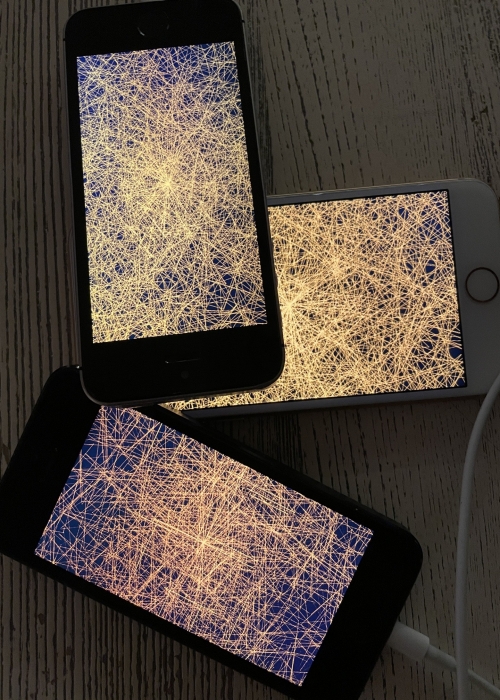Grad student Alec Mathewson brings maker-driven design learning into the high school classroom

Alec Mathewson is a recent graduate student in the Department of Design and Computation Arts at Concordia. His research is focused on the landscape of design education in high schools. Through his master’s thesis, "Design for the Art of Learning: Defining Challenges for Maker-Driven Design Activities and Design Education in Secondary Schools," Mathewson offers a fresh perspective on educational approaches to learning through design.
Situating his research within a school’s Fab Lab, or digital fabrication laboratory, Mathewson identified key challenges and opportunities. Notably, he observed the importance of having design constraints and awareness of process avoidance, in shaping impactful learning experiences for students within secondary-school environments.
‘Maker-driven design activities offer an inclusive approach to working with technology’
How did your research come about? Did previous findings in secondary schools inspire you?
Alec Mathewson: My interest in design was triggered by my observations studying design while working in a school integrating design and maker activities in a Fab Lab. I noticed a lack of awareness in high schools around critical making and creative uses of technology, and it motivated me to explore precedents on these learning experiences and use research-creation to address these challenges.
During my research, my work shifted from making Fab Labs more accessible toward reframing assumptions about creativity, technology and learning through design in high-school environments.
I wanted to encourage students and teachers to engage in design activities that support interdisciplinary learning and critical thinking, which can be challenging, as it requires dedicated time which there is very little of.
Can you explain the concept of "process avoidance"?
AM: Process avoidance became a way for me to describe a phenomenon in which students put energy, and sometimes a lot of creativity, toward avoiding the process of iterating toward the solution.
Students often take a “one-and-done” approach at school, whereas this kind of learning requires debugging and iteration. By exposing them to play, simplified technology, and by celebrating creative discoveries coming from mistakes, we can instill a sense of reassurance and confidence in the process. Students then become more accepting of the hidden — sometimes messy — steps to taking an idea and turning it into something tangible.
 Mathewson's design posters
Mathewson's design posters
Can you elaborate on maker-driven design?
AM: Maker-driven design activity is a hybrid term used to signify action-oriented and experiential project-based learning. It is imbued with a design literacy that comes from critical making, sustainable action, and creative uses of technology. At its core, it is a playful way to learn how research-creation can be used for learning.
Maker-driven design activities offer an inclusive approach to working with technology. Students don’t have to be interested in engineering to know how machines work, and the goal is to empower all students to favour construction over consumption. This can orient students to approach emerging tech, like artificial intelligence, more as an object to think with, supporting an active curiosity about how it works at a time when they are forming initial habits with technology.
Were there any surprising findings during your research and around “maker-driven” activities?
AM: What surprised me most was observing students engaging in maker-driven design activities and how effective it is as instilling a sense of focus and curiosity sense toward learning, without much instruction.
The other day, in one class I had different students tinkering with a robotic arm, playing with slow-motion cameras, throwing Lego bricks against a wall, cutting wood, measuring, snapping electronic circuits, etc. These students were actively discovering new ideas related to a learning goal they had set for themselves and the design problem they were looking to solve. However, as soon as we start to reach this state of flow in learning, the bell rings!
 Mathewson uses his own art to explore how to design maker-driven design activities. The photo shows patterns on the discarded phones, made using the logo programming language.
Mathewson uses his own art to explore how to design maker-driven design activities. The photo shows patterns on the discarded phones, made using the logo programming language.
How can maker-driven design address sustainability challenges within the school and potentially in broader community?
AM: Similarly to scientific thinking, the kind of design literacy that supports sustainable action should also be a fundamental understanding for all students. When integrated appropriately, maker-driven design activities have the potential to not only spread design literacy in schools but also foster creativity among students. It helps produce the mindsets necessary to navigate change, because it highlights an awareness of the impact of “things” and the traits needed to enact this awareness.
What are key recommendations for teachers based on your findings?
AM: Carving a little bit of time to learn the basics needed to design your own tools can radically change how you approach using technology. Practising, and sharing your learnings as well as your mistakes as you are making them is essential for setting a safe and inspiring environment and fostering a culture of continuous learning and creative confidence.
Find out more about the Department of Design and Computation Arts.